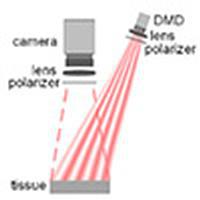当前位置:
X-MOL 学术
›
Opt. Lett.
›
论文详情
Our official English website, www.x-mol.net, welcomes your
feedback! (Note: you will need to create a separate account there.)
Deep learning model for ultrafast multifrequency optical property extractions for spatial frequency domain imaging
Optics Letters ( IF 3.1 ) Pub Date : 2018-11-15 , DOI: 10.1364/ol.43.005669 Yanyu Zhao , Yue Deng , Feng Bao , Hannah Peterson , Raeef Istfan , Darren Roblyer
Optics Letters ( IF 3.1 ) Pub Date : 2018-11-15 , DOI: 10.1364/ol.43.005669 Yanyu Zhao , Yue Deng , Feng Bao , Hannah Peterson , Raeef Istfan , Darren Roblyer

|
Spatial frequency domain imaging (SFDI) is emerging as an important new method in biomedical imaging due to its ability to provide label-free, wide-field tissue optical property maps. Most prior SFDI studies have utilized two spatial frequencies () for optical property extractions. The use of more than two frequencies () can vastly improve the accuracy and reduce uncertainties in optical property estimates for some tissue types, but it has been limited in practice due to the slow speed of available inversion algorithms. We present a deep learning solution that eliminates this bottleneck by solving the inverse problem to faster, with equivalent or improved accuracy compared to competing methods. The proposed deep learning inverse model will help to enable real-time and highly accurate tissue measurements with SFDI.
中文翻译:

用于空间频域成像的超快速多频光学特性提取的深度学习模型
空间频域成像(SFDI)由于能够提供无标签的广域组织光学特性图而成为一种新兴的生物医学成像新方法。先前的SFDI研究大多数都利用了两个空间频率()用于光学性质提取。使用两个以上的频率()可以极大地提高某些组织类型的准确性并减少光学特性估计的不确定性,但由于可用的反演算法速度较慢,因此在实践中受到了限制。我们提供了一种深度学习解决方案,可通过解决以下问题消除瓶颈 反问题 到 与竞争方法相比,速度更快,且具有同等或更高的准确性。拟议的深度学习逆模型将有助于使用SFDI进行实时且高度准确的组织测量。
更新日期:2018-11-16
中文翻译:

用于空间频域成像的超快速多频光学特性提取的深度学习模型
空间频域成像(SFDI)由于能够提供无标签的广域组织光学特性图而成为一种新兴的生物医学成像新方法。先前的SFDI研究大多数都利用了两个空间频率()用于光学性质提取。使用两个以上的频率()可以极大地提高某些组织类型的准确性并减少光学特性估计的不确定性,但由于可用的反演算法速度较慢,因此在实践中受到了限制。我们提供了一种深度学习解决方案,可通过解决以下问题消除瓶颈 反问题 到 与竞争方法相比,速度更快,且具有同等或更高的准确性。拟议的深度学习逆模型将有助于使用SFDI进行实时且高度准确的组织测量。











































 京公网安备 11010802027423号
京公网安备 11010802027423号